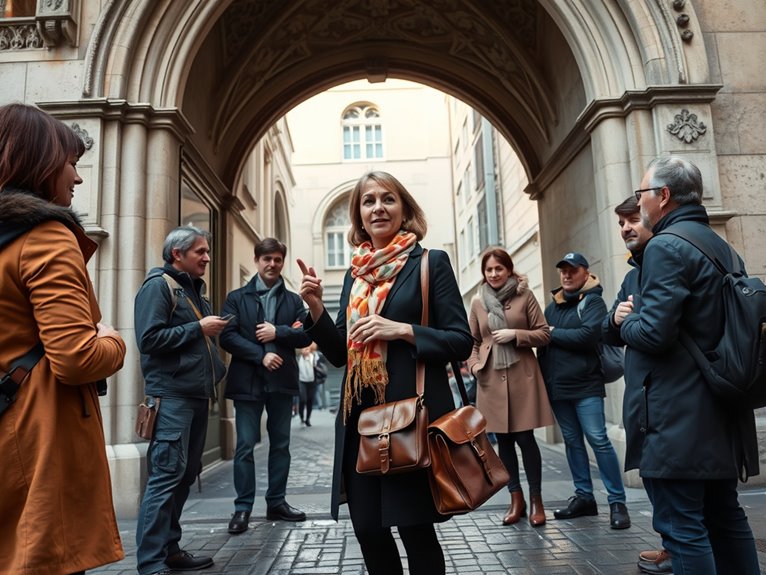
8 Unique Walking Tours in Paris With Specialist Guides
From my experience exploring Paris with expert guides, you'll discover eight unforgettable walking tours that reveal the city's hidden soul: descend into the ancient Catacombs, taste your way through Le Marais's food markets, hunt for street art in Belleville, trace literary giants in Saint-Germain-des-Prés, explore secret courtyards, capture perfect photos at dawn, uncover historical crimes in the Latin Quarter, and wander lesser-known gardens. Each tour offers unique insights that'll make you see Paris in a whole new light.
Underground Paris: Exploring the City's Ancient Catacombs
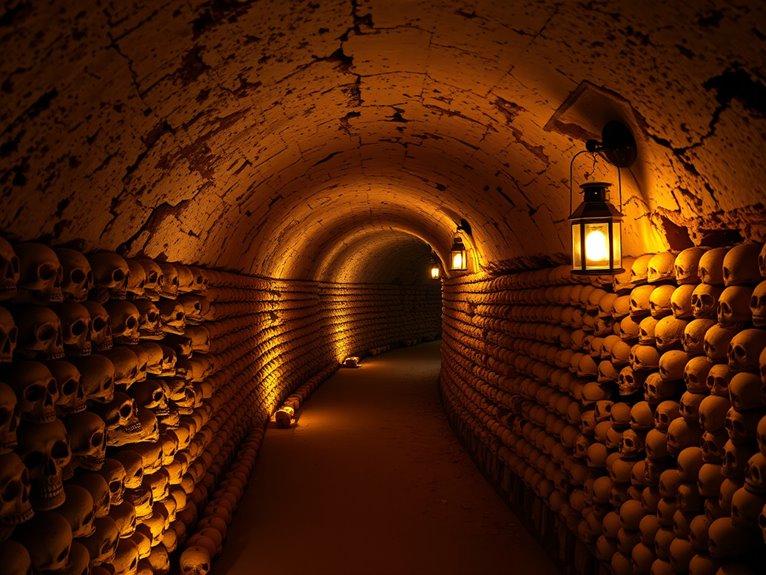
Beneath the romantic streets of Paris lies a haunting labyrinth of tunnels and chambers that hold the remains of over six million former residents. The Paris Catacombs, created in the late 18th century to address the city's overflowing cemeteries, represent one of the most unique and sobering attractions in the French capital. These underground ossuaries stretch for miles beneath the city, though only a small portion is open to the public.
This subterranean journey takes visitors 20 meters below street level, where carefully arranged bones and skulls line the walls in artistic patterns. The experience offers not only a glimpse into Paris's fascinating history but also provides insight into how the city dealt with public health challenges and death in previous centuries. The catacombs have inspired countless stories, served as a resistance hideout during World War II, and continue to captivate visitors with their eerie beauty.
Quick Facts:
- Opening Hours: Tuesday to Sunday, 9:45 AM to 8:30 PM (closed Mondays)
- Average Visit Duration: 45 minutes to 1.5 hours
- Admission: €16 for adults, free for under 18
- Temperature: Constant 14°C (57°F)
- Steps: 131 steps down, 112 steps up
- Photography: Allowed without flash
- Physical Requirements: Not suitable for those with mobility issues or claustrophobia
The Official Catacombs Entrance
Located at 1 Avenue du Colonel Henri Rol-Tanguy, the official entrance provides access to a 1.7-kilometer portion of the vast network. Visitors descend via a narrow spiral staircase before entering the ossuary section. The tour is self-guided with informative plaques in multiple languages. Insider tip: Book tickets online and arrive 15-20 minutes before opening to avoid the longest queues.
The Port-Mahon Gallery
Before reaching the ossuary, visitors encounter detailed stone carvings created by a former quarryman named Décure. These sculptures include a model of Port-Mahon fortress, where he was once imprisoned. This lesser-known section offers a unique glimpse into the lives of those who worked in these tunnels. Special attention should be paid to the intricate detail work, often missed by hurrying tourists.
Pro Tips:
The best time to visit is during weekday afternoons, particularly Wednesday and Thursday, when crowds are typically lighter. Consider booking a skip-the-line ticket, especially during peak tourist season (June-August). For photographers, bring a tripod for stable shots in the low light conditions, but be prepared to shoot without flash. Some of the most dramatic photos can be captured in the main ossuary chamber, where bones are arranged in geometric patterns.
Practical Advice:
Wear comfortable, closed-toe shoes with good grip, as the floors can be slippery and uneven. Bring a light jacket even in summer, as the temperature remains cool year-round. The catacombs are not wheelchair accessible and may be challenging for those with heart conditions or breathing problems. Water isn't allowed inside, but there are facilities at the entrance and exit. Consider downloading the official audio guide app before your visit, as Wi-Fi isn't available underground.
Food Markets & Culinary Traditions of Le Marais

Le Marais, one of Paris's most historic quarters, holds a treasure trove of culinary delights within its medieval streets. From centuries-old food markets to artisanal bakeries and specialty food shops, this neighborhood showcases the essence of Parisian gastronomy through its vibrant market culture and deeply rooted food traditions.
This historic Jewish quarter has evolved into a fusion of traditional French markets and international influences, creating a unique culinary landscape where classic French produce stands alongside Middle Eastern specialties and contemporary food innovations. Visitors can experience everything from traditional French cheese shops to contemporary food halls, making it an essential destination for food enthusiasts.
Quick Facts:
- Market Hours: Most open 8:00 AM – 1:00 PM (Tuesday-Sunday)
- Average Meal Cost: €8-15 for street food, €15-30 for market meals
- Best Times: Early morning (8:00-10:00 AM) for authentic local experience
- Payment: Cash preferred at markets; cards accepted at permanent shops
- Languages: Basic French helpful but not required
- Dietary Options: Extensive vegetarian/vegan options available
Marché des Enfants Rouges
The oldest covered market in Paris (established 1615) is a must-visit destination for food lovers. Located at 39 Rue de Bretagne, this historic market combines traditional French vendors with international food stalls. Open Tuesday-Sunday, 8:30 AM-8:30 PM. Insider tip: Visit the Moroccan stand for their legendary chicken tagine, but arrive before noon to secure a table.
L'As du Fallafel
This iconic establishment at 34 Rue des Rosiers represents Le Marais's Jewish culinary heritage. Their world-famous falafel sandwiches attract long queues daily. Open Sunday-Friday, 11:00 AM-11:00 PM. Hidden gem: Order the "special complete" and ask for extra harissa on the side for an authentic experience.
Marché Bastille
Though technically on the border of Le Marais, this massive open-air market (Boulevard Richard Lenoir) offers the neighborhood's best selection of fresh produce, cheeses, and artisanal products. Thursday and Sunday mornings. Secret tip: The best vendors set up at the northern end near Rue Amelot.
Pro Tips:
For the ultimate market experience, start your journey early morning (before 10:00 AM) when produce is freshest and crowds are thinner. Build relationships with vendors by showing interest in their products – many offer samples to engaged customers and can provide cooking tips. Consider bringing a small cooler bag if planning to purchase perishables like cheese or charcuterie.
Practical Advice:
Most markets have limited seating, so plan to either eat standing or take food to nearby squares like Place des Vosges. Always carry cash as many smaller vendors don't accept cards. Learn basic French market phrases for ordering and pricing – vendors appreciate the effort and often provide better service to those who try to speak French. Be mindful of market closing times (usually early afternoon) and remember that many vendors begin packing up 30 minutes before official closing time.
Street Art & Urban Culture in Belleville
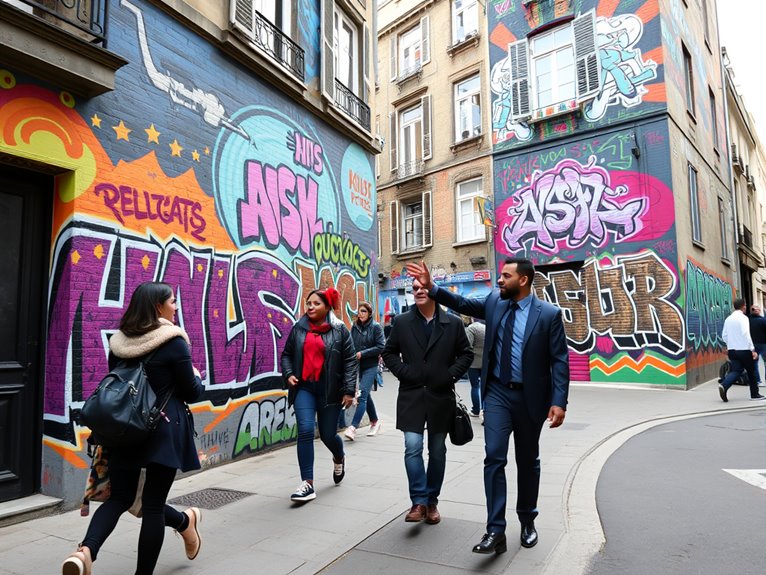
Once a working-class neighborhood, Belleville has transformed into Paris's most vibrant open-air street art gallery, where creativity flows freely across building facades and hidden alleyways. This diverse quarter, straddling the 10th, 11th, 19th, and 20th arrondissements, showcases an ever-changing canvas of urban expression, from massive murals to subtle stencil works.
The area's artistic renaissance began in the 1980s and has since attracted renowned street artists from around the globe, including Seth, Invader, and JR. Today, Belleville offers visitors an authentic glimpse into Paris's contemporary art scene, far from the traditional museums and galleries, while maintaining its multicultural charm and local character.
Quick Facts:
- Best visiting hours: 10:00-17:00 (optimal lighting for photos)
- Cost: Free to explore
- Duration: 2-3 hours for a complete tour
- Photography: Permitted everywhere (respect private property)
- Weather consideration: Best during dry weather
- Guide availability: Both self-guided and professional tours available
- Physical requirements: Moderate walking, some hills
Notable Street Art Locations:
Rue Dénoyez
The epicenter of Belleville's street art scene, this colorful street features constantly changing murals and graffiti. Artists regularly work here in broad daylight, offering visitors the chance to witness art in creation. Located just off the Belleville metro station, this street allows legal painting, making it a dynamic, ever-evolving gallery.
Insider tip: Visit on weekday mornings to catch artists at work.
Parc de Belleville
Beyond its stunning views of Paris, the park's surrounding walls showcase large-scale murals. The concrete surfaces provide perfect canvases for elaborate pieces, often incorporating social and political messages. Open from dawn to dusk, the park offers both art viewing and relaxation opportunities.
Insider tip: Check out the hidden stairways leading to the park for some of the most overlooked pieces.
Place Frehel
This small square features one of Belleville's most famous permanent installations: a trompe l'oeil mural depicting a library. The surrounding area houses numerous pieces by international artists, with new works appearing regularly.
Insider tip: Visit the nearby Aux Folies café, a former cabaret covered in street art, for an authentic local experience.
Pro Tips:
Timing is essential when exploring Belleville's street art scene. Early morning light provides the best photography conditions, while weekday afternoons offer opportunities to interact with artists. Consider visiting during the annual Belleville Artists' Open Studios event in May, when the neighborhood transforms into a massive art celebration with special installations and performances.
Practical Advice:
Wear comfortable walking shoes and bring a camera with wide-angle lens capabilities. Download a street art map application before visiting, as many pieces are tucked away in unexpected locations. While the area is generally safe, remain aware of your surroundings, especially when photographing in less-trafficked areas. Consider joining a local guide for your first visit to access hidden spots and learn about the cultural context behind the artworks.
Literary Legacy: Writers' Haunts in Saint-Germain-des-Prés
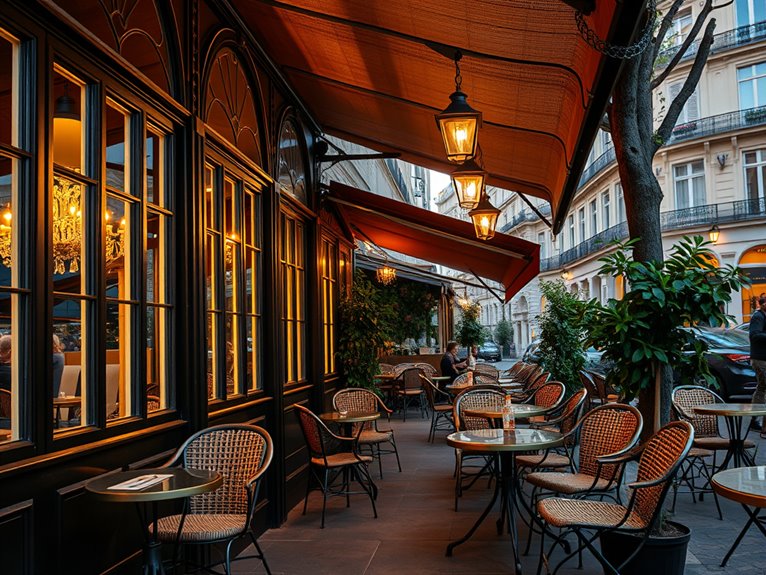
Saint-Germain-des-Prés stands as Paris's intellectual heartbeat, where literary giants like Hemingway, Sartre, and de Beauvoir once crafted masterpieces between sips of coffee and spirited debates. This historic neighborhood's cobblestone streets and iconic cafés continue to pulse with creative energy, offering visitors a chance to walk in the footsteps of the 20th century's most influential writers.
From the storied Café de Flore to the hidden apartments where great works were penned, this literary pilgrimage reveals how Saint-Germain-des-Prés shaped modern literature. The neighborhood maintains its bohemian spirit while providing intimate glimpses into the daily lives and favorite haunts of writers who changed the course of literary history.
Quick Facts:
- Best visiting hours: 10 AM – 7 PM (cafés open earlier)
- Most sites are free to view from exterior
- Photography allowed in public spaces
- Café prices: €5-15 for coffee, €15-30 for meals
- Walking distance: 2-3 kilometers total
- Guided tours available: €25-45 per person
- Prime seasons: Spring and Fall
- Metro stations: Saint-Germain-des-Prés (Line 4)
Les Deux Magots
This legendary café served as the primary meeting point for Sartre and de Beauvoir's existentialist circle. Located at 6 Place Saint-Germain-des-Prés, it operates daily from 7:30 AM to 1 AM. While tourists flock here for photos, few know about the annual literary prize still awarded by the café – time your visit during the January ceremony for a special experience.
Café de Flore
At 172 Boulevard Saint-Germain, Café de Flore remains virtually unchanged since Hemingway wrote here. Open daily 7 AM to 1:30 AM, the café's second floor offered the best writing spots for its famous patrons. Insider tip: The breakfast service between 7-9 AM maintains the quietest, most authentic atmosphere reminiscent of its literary heyday.
Rue Jacob
This historic street housed numerous writers, including Oscar Wilde's last residence at number 13. The street is free to explore any time, but buildings are private residences. Look for the discrete plaques marking notable residences – many tourists miss the small bronze marker at number 20 indicating where James Joyce finished "Ulysses."
Pro Tips:
For the most atmospheric experience, visit these literary landmarks during weekday mornings when tourist crowds are thinner. Bring a notebook and order a coffee to linger like the writers did – most cafés won't rush paying customers. Consider visiting during the annual Literary Festival in June when special events and readings take place in these historic locations.
Practical Advice:
While photos are generally permitted, respect current patrons' privacy in the cafés. Many establishments offer literary-themed menus or specialty items named after famous writers – these tend to be tourist-priced, but the experience can be worth the splurge. Consider purchasing a literary walking map from the tourist office for self-guided exploration, as some significant sites are easily missed without guidance.
Architecture Through the Ages: Hidden Courtyards & Passages
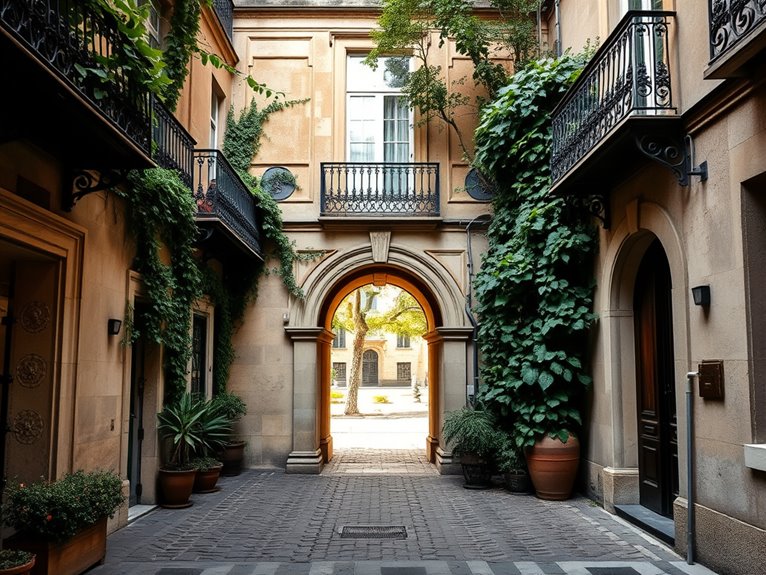
Paris's architectural legacy spans centuries, but some of its most enchanting spaces remain tucked away behind ornate doors and within secret passages. The city's hidden courtyards and historic passages couverts (covered passages) offer intimate glimpses into different architectural periods, from medieval to Art Nouveau, each telling its own story of Parisian life through the ages.
These architectural treasures provide refuge from bustling streets and reveal a private Paris few tourists discover. From the intricate ironwork of the Marais district's mansion courtyards to the glass-roofed shopping arcades of the 2nd arrondissement, these hidden spaces showcase the evolution of Parisian architecture while offering unique photography opportunities and historical insights.
Quick Facts:
- Best visiting hours: 10am-6pm (many courtyards close evenings)
- Photography: Permitted in public passages; private courtyards require permission
- Access: Some courtyards require door codes or guided tours
- Season: Year-round, but spring and fall offer best lighting
- Weather consideration: Covered passages ideal for rainy days
- Physical requirements: Moderate walking, some uneven surfaces
Notable Hidden Spaces:
Passage des Panoramas (2nd arr.)
The oldest covered passage in Paris (1799) features original gas lamps, intricate tile work, and vintage shops. Notable for its well-preserved 19th-century commercial architecture and philately shops. Open daily 6am-midnight. Insider tip: Visit at dusk when the vintage lighting creates a magical atmosphere.
Cour du Commerce Saint-André (6th arr.)
Medieval cobblestones and 18th-century buildings house historic cafés and boutiques. Location of Paris's oldest café, Le Procope. Access via multiple entrances on Rue Saint-André des Arts. Insider tip: Look for the remnants of Paris's city wall built by Philippe Auguste in 1200.
Village Saint-Paul (4th arr.)
A network of interconnected courtyards in the Marais, featuring antique dealers and artisan workshops. Open daily 11am-7pm. Hidden entrance on Rue Saint-Paul leads to four beautiful courtyards. Insider tip: Sunday afternoons bring special antique markets to the courtyards.
Passage du Grand-Cerf (2nd arr.)
Three-story iron and glass arcade featuring design shops and artisan workshops. Notable for its soaring 12-meter glass ceiling. Open Monday-Saturday, 8:30am-8:30pm. Insider tip: The best photos are taken from the third-floor balcony during mid-morning light.
Pro Tips:
Many private courtyards are accessible during European Heritage Days (Journées du Patrimoine) in September, when normally closed spaces open to the public. For photography, early morning provides the best light and fewer people. Some passages and courtyards connect to create shortcuts through neighborhoods – learning these can enhance your exploration and help avoid tourist crowds.
Practical Advice:
Respect resident privacy in courtyards that are part of private residences. Carry a detailed street map as many passages aren't marked on tourist maps. Consider joining a specialized architectural walking tour for access to normally restricted courtyards and expert historical context. Many passages are closed on Sundays, so plan accordingly. Keep voices low in residential courtyards and avoid flash photography near windows.
Photography Walk: Capturing Paris's Secret Angles
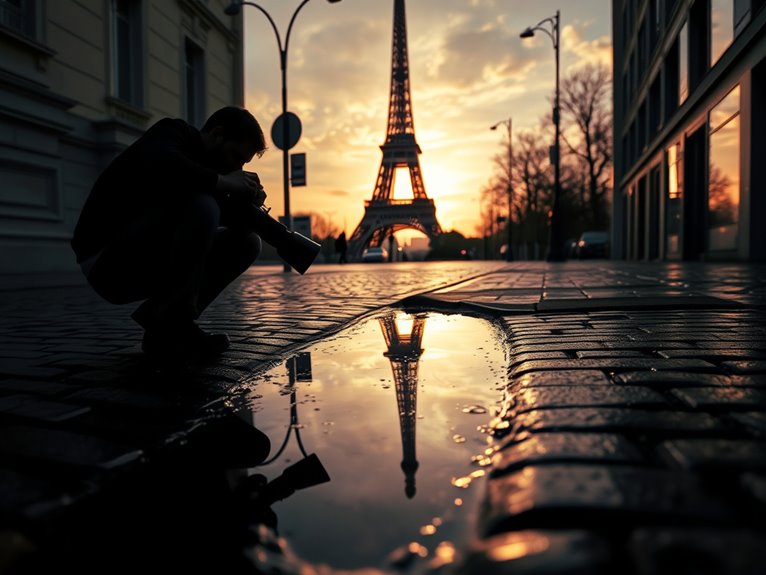
Paris's timeless beauty has captivated photographers for generations, but beyond the iconic shots of the Eiffel Tower and Notre-Dame lies a treasure trove of hidden photographic opportunities. The city's intimate courtyards, winding backstreets, and lesser-known vantage points offer photographers unique perspectives that capture the authentic spirit of the City of Light.
This photography walking tour guides you through carefully selected locations that combine artistic potential with historical significance, revealing Paris through a lens that most tourists never discover. From the early morning light hitting centuries-old facades to the golden hour illuminating secret passages, these spots provide exceptional photographic opportunities throughout the day.
Quick Facts:
- Best Photography Hours: Dawn (6-8 AM) and Golden Hour (1 hour before sunset)
- Equipment Recommended: Wide-angle lens, tripod, ND filters
- Physical Requirements: Moderate walking (5-7 miles total)
- Season: Year-round, with autumn offering ideal lighting conditions
- Photography Permits: Not required for personal photography
- Best Weather: Overcast days for even lighting, or clear skies for dramatic shadows
Hidden Gems for Photography:
Rue Crémieux
A cobblestone street lined with pastel-colored houses, offering perfect symmetry and vibrant backgrounds. Located in the 12th arrondissement, this street is best photographed early morning before residents begin their day. Insider tip: The houses at numbers 8 and 12 feature regularly changing artistic doors that locals update seasonally.
Square Montsouris
An elevated park in the 14th arrondissement providing unique angles of the city skyline without tourist crowds. Open daily from sunrise to sunset, this location offers exceptional morning light conditions. Insider tip: The northwest corner features an unmarked staircase leading to a hidden viewpoint perfect for cityscape shots.
Passage des Panoramas
The oldest covered passage in Paris, offering opportunities for moody interior architecture shots with natural light streaming through the glass ceiling. Located in the 2nd arrondissement, this spot is ideal for rainy day photography. Insider tip: Visit between 3-4 PM when light beams create dramatic shadows through the passage's Victorian architecture.
Pro Tips:
Master the art of Paris photography by working with the city's natural rhythm. Early morning sessions (before 8 AM) offer empty streets and perfect light for architecture shots, while evening blue hour (just after sunset) provides ideal conditions for capturing the city's romantic atmosphere. Consider using a 35mm prime lens for street photography, as it closely matches the human eye's perspective and performs well in low-light conditions common in Paris's narrow streets.
Practical Advice:
Respect local privacy laws and avoid photographing people without permission. Carry a lightweight but sturdy tripod for low-light situations in passages and courtyards. Many locations require metro access, so purchase a day pass for unlimited transportation. Keep equipment minimal and secure, as some areas can be crowded. Always have a rain cover for your camera, as Paris weather can change quickly, and some of the most atmospheric shots come during or just after rain showers.
Historical Crime Scenes & Mysteries of the Latin Quarter
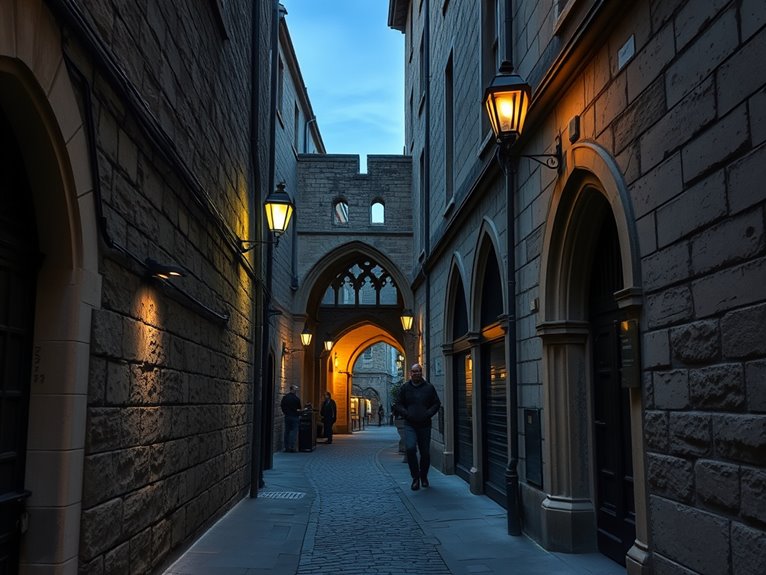
The Latin Quarter of Paris harbors centuries of shadowy tales behind its picturesque facades and charming cobblestone streets. From medieval murders to revolutionary conspiracies, this historic district has witnessed some of Paris's most intriguing crimes and unexplained mysteries, making it a fascinating destination for those interested in the darker side of Parisian history.
Walking these ancient streets reveals stories of alchemists' secret laboratories, notorious poisoners, political assassinations, and unexplained disappearances that have puzzled historians for generations. This guide explores the most compelling historical crime scenes and mysterious locations that defined the Latin Quarter's notorious reputation during different periods of Parisian history.
Quick Facts:
- Best visiting hours: Late afternoon to dusk (4-8 PM)
- Tour duration: 2-3 hours
- Cost range: €15-30 for guided tours, free for self-guided
- Photography: Permitted everywhere except certain church interiors
- Terrain: Moderate walking with some hills and stairs
- Weather consideration: Tours run year-round but best in spring/fall
Notable Locations:
Place Maubert
Once Paris's primary execution site, this square witnessed countless public punishments, including the burning of alchemists and heretics. Today's peaceful plaza belies its gruesome history. Located in the 5th arrondissement, it's accessible via Metro station Maubert-Mutualité. The square comes alive with market activities on Tuesdays, Thursdays, and Saturdays. Insider tip: Look for the subtle marble plaque marking where the execution platform once stood.
Rue de la Bûcherie
Home to the infamous "Beast of the Bastille" murders in the 1980s, this street also housed medieval apothecaries suspected of poisoning prominent figures. Visit Shakespeare and Company bookstore at #37 for a pleasant counterpoint to the street's dark history. Insider tip: The building at #4 still has original 15th-century cellars where suspicious potions were allegedly brewed.
Collège de Sorbonne
Beyond its academic prestige, the Sorbonne witnessed numerous mysterious deaths and disappearances during the French Revolution. The courtyard is open during university hours (8 AM-8 PM). Insider tip: Check the southeastern corner for bullet holes allegedly dating from the 1944 Liberation of Paris.
Pro Tips:
For the most atmospheric experience, time your walk to begin about two hours before sunset. The lengthening shadows and golden light create the perfect ambiance for storytelling and photography. Consider visiting during shoulder season (March-April or October-November) when tourist crowds are thinner and the early darkness enhances the mysterious atmosphere. Many buildings referenced in these dark tales are still private residences or active institutions, so maintain respectful distance and volume.
Practical Advice:
Wear comfortable walking shoes suitable for uneven cobblestones and bring a small flashlight or phone light for examining architectural details in darker corners. While the Latin Quarter is generally safe, stay aware of your surroundings, especially after dark. Most guided tours require advance booking, and many offer discounts for students and seniors. Consider downloading offline maps as the narrow streets can sometimes interfere with GPS signals.
Gardens & Green Spaces: Paris's Lesser-Known Oases
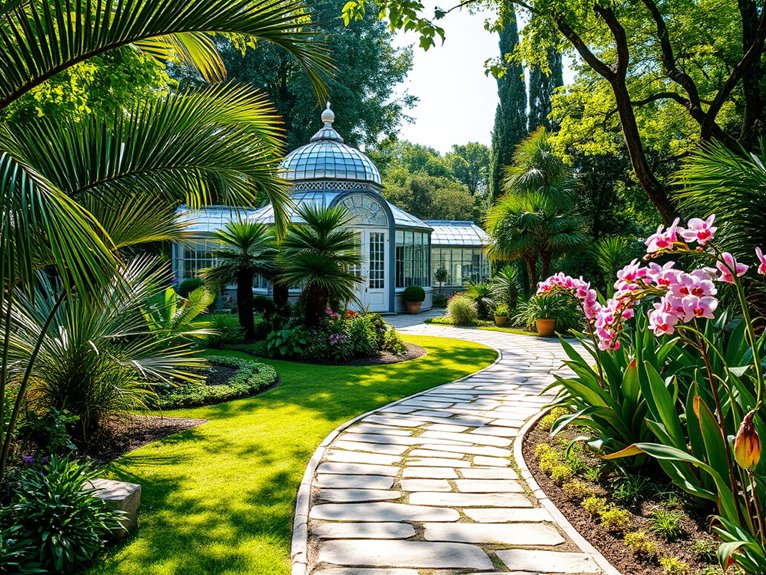
Walking Tours in Paris: Gardens & Green Spaces
Paris's Lesser-Known Oases
While the Luxembourg Gardens and Tuileries draw millions of visitors annually, Paris harbors dozens of secret gardens and lesser-known green spaces that offer peaceful retreats from the city's bustling streets. These hidden oases provide authentic glimpses into Parisian life, where locals read, picnic, and enjoy quiet moments away from tourist crowds.
From converted railway tracks to medieval monastery gardens, these verdant spaces tell fascinating stories of Paris's evolution while providing welcome respite for tired travelers. Each garden featured in this guide offers unique character, historical significance, and that special Parisian charm without the overwhelming crowds of more famous locations.
Quick Facts:
- Best visiting hours: Early morning (8-10am) or late afternoon (4-6pm)
- Cost: Most gardens are free; some specialized gardens €2-6
- Photography: Morning light best for photos; tripods usually allowed
- Seasonal highlights: April-June for flowers, October for fall colors
- Accessibility: Most gardens wheelchair accessible
- Facilities: Limited restrooms; bring water
Jardin des Plantes de l'École du Breuil
This teaching garden in the 12th arrondissement showcases French formal garden design alongside contemporary horticultural techniques. Open year-round, this 23-hectare space features themed gardens, including medicinal plants and rare species. Location: Route de la Ferme, 75012. Free entry.
Insider tip: Visit during student practical sessions to watch future master gardeners at work.
La Petite Ceinture
This abandoned railway line turned linear park offers 32 kilometers of elevated walking paths through hidden Paris. The 15th arrondissement section provides the best-maintained stretch, with wild gardens and original rail features. Access points near Rue Olivier de Serres.
Insider tip: Look for the original station house at Square Charles Péguy, now a community garden.
Jardin Alpin du Museum
Tucked within the Jardin des Plantes complex, this small mountain garden recreates alpine environments with over 2,000 species. Entry €4, open April-October, mornings only.
Insider tip: Visit in May when rare Himalayan blue poppies bloom.
Pro Tips:
The best photography opportunities arise during the "golden hour" before sunset when the gardens are bathed in warm light. For the most authentic experience, pack a picnic and arrive around 12:30, when local office workers take their lunch breaks in these spaces. Many gardens offer free guided tours in French; even with limited language skills, these tours reveal hidden features and seasonal highlights.
Practical Advice:
Most gardens close at sunset, and some lock their gates promptly. Carry a printed map as these spaces often hide behind unmarked walls or require navigation through residential areas. Many gardens prohibit sitting on grass; bring a blanket if planning to picnic. Water fountains are rare, so bring supplies for longer visits.
